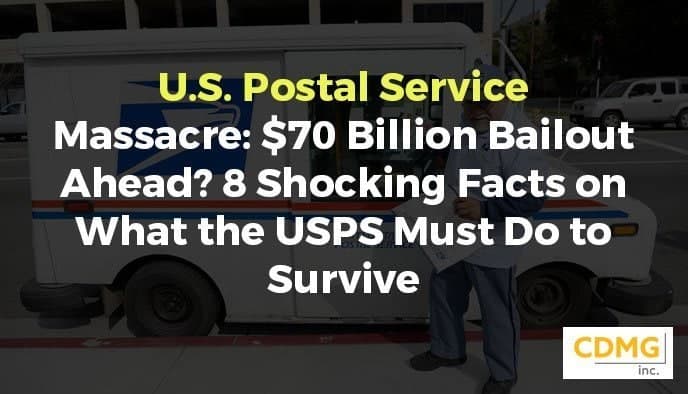The U.S. postal service burned through $2.3 billion this quarter.
It could run out of money as early as 2020.
With its huge postal increase earlier this year, marketing mail plummeted from 3,982,000,000 to 3,681,000,000 pieces.
Packages and first class mail volume were also down.
Losses were up from the $1.49 billion deficit from the same period last year.
Losses from 2007 to 2018 were about $70 billion.
But operating expenses for this quarter were up 4.3%: $797 million – $19.3 billion. That’s despite not making required healthcare payments to employees.
Taxpayers are facing a $70 billion bailout.
Why is this happening?
Because the United States Postal Service is appallingly dysfunctional. It’s an out-of-control bureaucracy.
And, typical of any bureaucracy, it’s resistant to any sort of change or positive progress.
Here are 8 facts you need to know now about the inefficient, wasteful Postal Service…and what needs to be done to reform the USPS before a $70 billion bailout is necessary.
Fact #1: The USPS has hiked up postal rates for 2019, killing business and innovation.
The 10% postage increase earlier this year caused at least three unintended consequences:
- Fewer mailing pieces
- Less revenue
- A larger deficit
The last postal rate hike was a huge job killer — and the post office, the consumer and business were the victims.
My direct-mail clients of my advertising agency won’t send as much direct mail – and some won’t send any – with the hikes.
They’ll lose new clients and experience less revenue from existing clients.
The clients’ prospects won’t get their special offers. They’ll lose a great product.
And instead of the Postal Service generating increased revenue, it’s generating less.
The insanity has to stop.
Fact #2: The United States Postal Service (USPS) has lost $70 billion…that’s right, billion…over the last 11 fiscal years.
No private company could stay in business if it lost an average of nearly $6 billion every year for 11 years…
But government-protected agencies don’t have to operate profitably.
Bureaucrats don’t care if they lose money because they know taxpayers will always bail them out … whether they want to or not.
USPS bureaucrats don’t care that their government-mandated business model is unsustainable…or that operating expenses keep increasing while whole revenue declines.
All they care about is collecting their paychecks and keeping their cushy taxpayer-backed benefits.
Fact #3: The USPS management team is nonexistent.
A private business must have an efficient team to run well. But the USPS has virtually no management team right now.
The USPS is supposed to be run by an 11-member Postal Board of Governors, including nine members appointed by the President and approved by Congress and the Postmaster General and Deputy Postmaster General.
The Postal Board of Governors has the following primary responsibilities:
- Advise the Postal Service on management
- Approve rate hikes
- Fire the Postmaster General if necessary
The board must have six members to have a quorum. Currently, they only have four members: The other seven seats are vacant.
In fact, the Board of Governors has taken full advantage of this circumstance…
Without a quorum, the Board established three new rules out of thin air:
- Hiring, firing, and postal rates can be decided without a quorum.
- No specific number of governors are needed to make decisions.
- A “Temporary Emergency Committee” has been established giving the Postmaster General and her top staff complete authority.
What the post office desperately needs is oversight and accountability – required in any efficient business.
Fact #4: The postal bureaucracy is archaic, resistant to change.
The USPS makes decisions not based on market need and business reality … but based on what pleases bureaucrats, unions, and politicians.
For example, in 2014 the Postal Service set up an agreement with Staples that allowed its employees to operate post office desks inside Staples’ retail outlets.
This was a great business decision, and convenient and popular with Staples customers … but not with the American Postal Workers Union.
The union immediately began staging protests at selected Staples outlets … and eventually succeeded in obtaining an order in 2016 by a National Labor Relations Board Administrative Law Judge to discontinue the program.
This is just one example of crushing innovation…or doing the most expensive activity.
Fact #5: The Postal Service is currently a government-protected monopoly that would benefit from healthy competition.
Monopolies don’t work – especially the bureaucracy monopoly…
Only choice and competition can create efficiency and progress.
If the auto industry, the computer industry – including email and texting – and eye surgery were bureaucratic monopolies, their products would be very expensive, second-rate, and immune to positive change.
If the horse and the buggy industry were protected the way the Postal Service is, we’d be riding horses instead of driving high-powered cars…
We’d have giant computers like in the 1960s, not iPhones in every home…
We’d have government-approved eye glasses, not Lasik.
The USPS has tried to stop innovations and advances in postal delivery…
Years ago, it tried to stop UPS, FedEx, and other private delivery services…
Fortunately for businesses and consumers, the government monopoly failed.
Then the USPS tried to control email … but fortunately for businesses and the consumer, they failed.
Fact #6: Postal vehicles are falling apart – and now the USPS has responded with a pricey, “eco-friendly” and wasteful “solution.”
More than half of all postal vehicles are more than 20 years old, and need to be replaced desperately.
But despite their massive debt, the post office has decided to purchase massively expensive but “green” hybrid vehicles.
Even with better mileage, hybrid vehicles are more expensive. And the USPS is planning on spending $6 billion for these new cars in the next 10 years – sinking them further into debt.
A private business could never make this sort of a business decision. But a bureaucrat – removed from reality and totally unaccountable to spending – doesn’t make decisions to benefit taxpayers. They make decisions to advance their own self-interest and advance a political agenda.
Fact #7: The Post Service shouldn’t be controlled by Congress.
Much of the post office’s dysfunction is caused by the United States Senate and House.
Individual members of Congress prevent the free market from working:
They prevent the closure of inefficient postal facilities.
They prevent the hiring of good people.
They block implementation of technical improvements.
They act to please their union donors rather than to benefit the American people.
Any proposal to reform the USPS will see pushback from members of Congress who want to push a socialist agenda.
Fact #8: President Trump’s team is proposing to privatize the post office in a massive restructuring.
Privatization could transform the post office…help get it out of debt…and ultimately benefit taxpayers and consumers.
It’s the only hope before a massive government bailout.
Here are further steps that President Trump must make that will help end the appalling dysfunction of the USPS…and protect taxpayers like you and I from paying for it:
- Trump must ignore the bureaucracy, unions, and politicians who want to stop this proposed change and any other sort of progress.
- He must fight against any postal rate hike.
- He must nominate members to the Board of Governors and hire staffers who understand business, competition and job creation.
Contact your representatives right now and tell them you support the proposed privatization of the USPS!

![Tariffs and Your Advertising: Strategies for Surviving, Growing and Dominating Your Market [3 Keys to Success]](https://cdmginc.com/wp-content/uploads/2025/04/AdobeStock_1187878954-scaled-500x383.jpeg)
